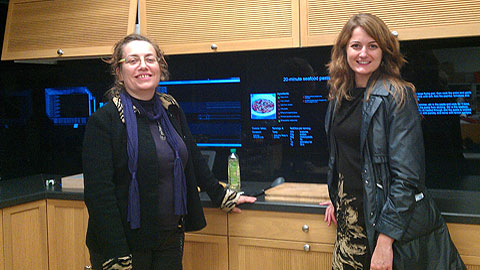New method helps learn languages while cooking

01/10/2014
The project included the participation of research groups from the universities of Helsinki (Finland), Newcastle (UK), Modena and Reggio Emilia (Italy), Paderborn (Germany) and UAB researchers Dolors Masats and Marta Juanhuix, lecturers of the Department of Language, Literature and Social Science Teaching and members of the Research Group in Plurilingual Interaction and Teaching (GREIP).
LanCook is funded by the European Union as one of the projects under the Lifelong Learning programme and is a new language learning method incorporating digital technology to a set of cooking utensils with the aim of creating a unique context in which the technology helps users learn languages while they cook. Its objective is to demonstrate both the utility and the power of materials to promote language learning in real-life situations. At the same time, it has served to develop a system of adhered sensors which can be used in a wide variety of real-life tasks in which individuals must interact with the activity, such as in cooking.
When testing LanCook, learners were paired off and received instructions from a digital tablet, which acts as an interactive cooking set, and are guided step by step in the elaboration of typical dishes from different parts of Europe. For each of the seven languages included in the digital cooking set - Catalan, English, Finnish, French, German, Italian and Spanish - there are two recipes and cultural information.
The tablet contains a software designed especially for this project by computer specialists from Newcastle University, the coordinating university. The programme recognises the movement of sensors incorporated in the cooking utensils and in the containers for the ingredients for each recipe. This wireless sensor technology is similar to what some video consoles use and both the software and hardware in the cooking set are designed to work in any normal kitchen. In addition, the learners can interact with the cooking set to ask for help if they do not understand the instructions. This help is offered in the form of audio messages recorded at a slower speed than that of the instructions and accompanied by images and subtitled videos.
It has taken three years to develop the project and during this time data was gathered on how to foster the learning of a language by using such a proposal. A total of more than 300 language learners were able to take part in the project and experience what it is to learn a language while they cook using a digital cooking set.
Professor Paul Seedhouse of Newcastle University highlights that LanCook creates a real-life context which motivates users, who gain confidence and not only learn a foreign language but also come into contact with the related culture in a more active manner.
Lecturers Dolors Masats and Marta Juanhuix consider that LanCook offers an innovative proposal with which to promote the acquisition of practical skills in foreign languages in a formal education context. That is why they were keen on taking the cooking utensils to a primary school to test it out with young English language learners and offer them the chance to learn English with a real-life objective.
LanCook is presented as an open system, in which languages and recipes can be added and technological improvements made to the system. The project team does not discard developing this method for other digital supports, such as a mobile phone application.
Two recipes in each language
LanCook allows users to prepare up to fourteen different recipes, two for each of the seven languages included in the project.
UAB researchers were in charge of creating and piloting the material which will allow students to learn Catalan and Spanish. The Catalan language option includes recipes for typical Catalan desserts such as a Crema Catalana and Bunyols de Vent, while those learning Spanish will be able to prepare typical Spanish dishes such as a cold soup called Salmorejo, or a Spanish omelette.
The German cuisine proposals are a potato salad, Kartoffelsalat, and a rice pudding, Milchreis. For those practicing English, users will be able to follow the recipe for making Scones, a type of muffin filled with raisins or cranberries and served with marmalade and cream, and Chicken Methi Malai, a dish created especially for the project and which is a fusion between a UK and an Indian dish. Finnish recipes include a Kalakeitto, a fish soup which generally uses salmon as the main ingredient, and a Marjakiisseli, a wild fruit pudding. The French cuisine proposes a cream caramel with pears, Clafoutis aux poires, and a Croque-monsieur, a hot ham and cheese sandwich. And finally, the Italian recipes include a pasta dish made with olives and capers or napolitana sauce (Penne olive e capperi and Pasta alla Napoletana) and meat rolls (Involtini alla Contadina) stuffed with capers, olives and anchovies.
www.europeandigitalkitchen.com